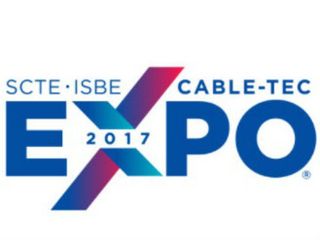Cable-Tec Expo: News Briefs I

Here’s a snapshot of what else will be making news and will be on show at this week’s SCTE•ISBE Cable-Tec Expo in Denver.
Read More: Complete coverage of Cable-Tec Expo 2017
-Hitron Technologies (Booth #395) said it will team up with Cisco Systems on a Full Duplex DOCSIS demo that will show how DOCSIS 3.0 modems (including Hitron’s “Coda” family of products) can operate on the same network as FDX-capable DOCSIS 3.1 modems. That demo will work in tandem with some new D3.1 interference group capabilities that are required for FDX, which will support upstream and downstream traffic in the same block of spectrum and help cable operators bring multi-gigabit symmetrical speeds to their HFC networks. Cisco intends to demo seven modems based on Intel Puma silicon. Hitron noted that its CODA-45 models use a 5-85 MHz front end, and the CODA-47 models can be switched to support networks that support a high-split that enables a wider upstream block of 5-204 MHz.
-MaxLinear announced that its D3.1 chipsets will be used to help power Hitron’s FDX demo at the show, including its MxL277 and MxL278 Full-Spectrum Capture digital front-end receivers and its MxL236 upstream programmable gain amplifier. Those products are being used in tandem with Intel Corp.’s Puma 7 DOCSIS 3.1 SoC.
-ATX Networks (Booth #895) said it will highlight its range of devices for encoding, decoding, video insertion and transcoding. ATX noted that its DVIS and DigiVu line for insertion of local content has traditionally been used for on-premises local inserts into HFC-based multiple-dwelling u nits, but recently evolved them to also support inserts into RF-over-Glass, PON fiber deep, and several IPTV-based environments. ATX, which acquired Pico Digital last year, also will show off a lineup of video encoders, including the PD1000 and PD100, DVB gateways, and a mini cable modem termination system (CMTS). Also on show will be the VersAtivePro, a license-free transcoding platform.
-Teleste Intercept (Booth #177), a Teleste-Antronix joint venture announced in July, will show off the ICON9000, a remote PHY node that aims to help operators shift to a next-gen architecture that promises to drive more capacity and power-efficiency into the HFC network. Teleste Intercept said the ICON9000 has been designed to offer operators 1.2 GHz capacity with remote PHY capability and a transition path to distributed network architectures. The product, manufactured by Teleste and equipped with a built-in spectrum analyzer, meets North American cable industry requirements, the JV said.
-Espial (Booth #959) said it’s focusing on showing products that can help operators deliver IP video services, and will demo its Elevate cloud-based Software as a Service (SaaS) video platform, which is now in use by about 40 operators around the world. Elevate supports a variety of video services and apps, including IPTV, support for Android TV, and an interface that ties it together. It’s supporting voice control on its platform through Amazon Alexa.
-Alpha Technologies (Booth #677) has launched the AlphaGateway BSC, a small cell broadband platform for HFC networks. Alpha views the new gateway, an addition to its lineup of outside gateways, as a way to bridge the mobile capacity that a cell operator needs and what a cable operator can provide. The AlphaGateway BSC connects to the HFC network through a power-passing tap on the strand. The four power outputs on the device provide 80-90VAC connections, totaling 300W. An internal DOCSIS 3.1 modem provides 1 Gbps backhaul for an external router, the company said.
Multichannel Newsletter
The smarter way to stay on top of the multichannel video marketplace. Sign up below.
-Broadspeak (Booth #1653) will show off its multiscreen video capabilities, led by demos of the nanoCDN multicast adaptive bitrate platform that works in tandem with broadband gateways, cable modems, WiFi routers, and set-tops. Use cases on show this week include “zero latency” for live video streaming and cloud DVR options for start-over, time-shifted and catch-up TV applications.
-ProLabs (Booth #1412) will show off its “unlimited” fiber connectivity products for MSOs that are facing pressure to accommodate node splits as well as emerging Remote PHY and fiber deep architectures. ProLabs said its High Density CWDM transceivers are tailored for node splitting, as it enables operators to pack more into a fiber by carrying multiple signals down an individual fiber connection. ProLabs is also set to relaunch its Passive WDM Multiplex (Mux) and Demultiplex (Demux) portfolio, including “slim” Head End Demultiplexers; its Compact and Field Multiplexers, and its High-Density Mux/Demux solutions.
-Viavi (Booth #1387 and #153), fresh off its acquisition of Trilithic in August, will show and demo a complementary mix of test and measurement products for operators from its newly combined portfolio. Notably, Viavi’s XPERTrak virtualized assurance system now integrates Trilithic’s plant leakage data for a converged, cloud-based, contractor-friendly test and measurement portfolio. Viavi has also made updates to its OneExpert CATV signal meter that streamlines testing, verification and troubleshooting, the company said. It will also show updated fiber-to-the-home solutions and its lineup of multifiber test tools, including the SmartClass Fiber MPOLx (MPO optical loss testing), FiberChek Sidewinder (MPO inspection), and the MPO Optical Switch Module (MPO OTDR certifying) for the T-BERD/ MTS-4000 platform.
-ATX Networks (Booth #895) will show a range of optical transport products aimed at helping MSOs boost capacity and efficiency of their HFC networks while supporting DOCSIS 3.1, a new platform that delivers multi-gigabit speeds on cable networks. ATX’s Chromadigm hybrid transmitter technology is aimed at long haul multi-wavelength transmission, hub collapses, fiber deep node deployments and RFoG/PON architectures, the company said. ATX Networks will also highlight the new ChromaFlex II, a chassis that integrates RF management into the modular optical platform that, it claims, can reduce rack space in the headend by up to 75%.










